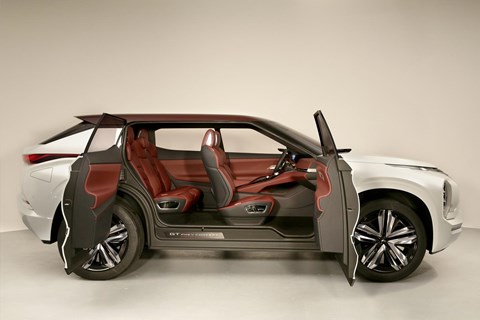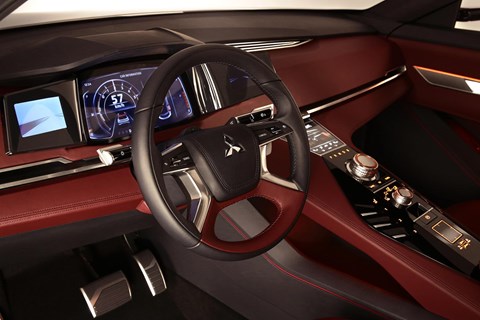► Tri-motor plug-in hybrid SUV concept sees return of S-AWC and AYC
► 75-mile electric range, 26g/km CO2 emissions, 180kW of power
► Updates for Mitsubishi Outlander and ASX production models as well
It would be easy to dismiss the Mitsubishi GT-PHEV concept at Paris 2016 as a Range Rover Sport pastiche rendered through the digital world of Tron. But at its heart, Mitsubishi still wishes it was building world championship-winning rally cars, and has equipped this wannabe high-end SUV coupe with a techy-tech iteration of its Super All Wheel Control (S-AWC) four-wheel drive system, complete with three electric motors and a new electric version of that Evo favourite, Active Yaw Control.
While this is all pie in the sky until Mitsubishi confirms the GT-PHEV previews the next Shogun (it’s actually sized between Shogun and Outlander and apparently not an indication of the replacement for either) it does kinda give this machine the potential handling chops of a high-riding Porsche 918 or Honda NSX.
My, what a big face the GT-PHEV has…
With more chin than Jimmy Hill, the GT-PHEV certainly has a distinct visage. Front and slightly higher than centre (good luck with the pedestrian impact rating, guys) is an evolution of the Dynamic Shield grille design that started appearing on Mitsubishis back in 2014. The piano black finish hide active aero shutter, while the headlights on either side are in an unusual vertically-stacked configuration.

Elsewhere the exterior design is described as ‘intense’, and ‘meant to give a sense of reassurance to the driver while also stimulating their quest for adventure expressed through the body’s ingot-like surface composition’. We think this means it looks chunky. As the third example of the brand’s ‘Form follows Function’ design philosophy (after 2015’s Concept XR PHEV II and eX Concept models), the GT-PHEV is apparently expressing ‘augmented possibilities’ as well.
At the back the C-pillar ‘takes an airplane’s tail fin as its motif’, while the floating roof is finished in dark burgundy to match the leather on the inside. The taillights are joined like a visor, and feature 14 inset vertical units; the bumpers have a rubber coating at both ends.
Tell me more about the triple-motor PHEV system
The current Outlander PHEV uses a two-motor drivetrain – one at the front, one at the back – and a 2.0-litre petrol engine beneath the bonnet to supplement the motors and the battery pack under the rear floor.
The GT-PHEV concept previews a new system, which uses three electric motors and a 2.5-litre petrol engine, intended for more prestigious future Mitsubishi plug-in hybrid products; there’s one 90kW (around 120bhp) electric motor for the front wheels, and two 45kW (around 60bhp) electric motors for the rear wheels. As per the Outlander, power for the motors is generated by the petrol engine (which can also directly drive the wheels) or comes via the 25kWh ‘next-generation’ battery pack under the floor.

That’s enough battery power for up to 75 miles of electric-only running, helping the GT-PHEV to a total theoretical range of 750 miles and CO2 emissions of 26g/km. Weight optimisation, low drag bodywork and speed-sensitive auto height-adjusting suspension also contribute.
Why is any of this exciting?
The clever bits are in the details. At the front, for example, there’s a two-speed transaxle, with a high reduction ratio for fuel efficiency and a low reduction ratio for overtaking performance. Torque can also be actively split between the front wheels to improve cornering.
At the back the Active Yaw Control comes in; this manipulates the electric motors to achieve a torque differential between the two rear wheels and, according to Mitsubishi, ‘generates a yaw moment that improves cornering capability and also helps to create a level of agile and feel-good handling that would seem improbable for a car of its size.’

It can even achieve ‘an amplitude’ of torque across the rear wheels, boosting the torque output on either side beyond what a single motor can deliver. Expect whatever production vehicle comes out of this concept to go round corners alarmingly quickly.
And what’s the GT-PHEV like on the inside?
Apparently the ‘horizontal dashboard’ is a ‘new theme’ for this concept… There was us thinking most dashboards are horizontal. Anyway, the instrument cluster in an all-digital affair, with a pair of monitors for the cameras that replace the exterior mirrors on either side and a head-up display above.

There’s also a panoramic roof and a black, burgundy and silver colour palette throughout – the quality isn’t quite as intricate as Lexus, but it’s pretty good, and looks more production ready than pure fantasy. The large opening created by the suicide rear doors is your typical concept car staple, however, and not as likely for any real world output.
Naturally there’s a load of connected car tech as well, including nav guidance that takes account of weather and topography to manage both efficiency and the adaptive elements of the chassis.
What else is Mitsubishi showing at Paris 2016
Basking within millimetres of the concept’s limelight, the Outlander has been updated again. Perhaps the most significant part of this is the new EV priority button for the PHEV, which means you can finally tell the car to not use the petrol engine at all until the battery runs out. The plug-in hybrid also gets Apple CarPlay support, plus new Blind Spot Monitors, Rear Cross Traffic Alert and the addition of pedestrian detection to the Forward Collision Mitigation system.
There are lighting updates, too, plus a new ‘AC 1500W Power Supply’, which enables you to drive up to four hours on battery power alone (with the petrol engine merely topping the juice up behind the scenes).
Meanwhile the Outlander diesel graduates to a smarter, PHEV-style centre console, and will be offered with much of the same extra tech; this upgrade is set to hit showrooms late in 2017.
Finally, the smaller Mitsubishi ASX crossover receives a Dynamic Shield front-end facelift at last, with new bumper and grille design. There are no mechanical updates, but 2017 ASX models will also feature a shark fin aerial (woo), extra rear seat padding (hoo) and new seat material (time for a sit down).
See more from the French capital’s 2016 motor show